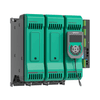PID and power controllers for synchronized thermal profile management of sintering furnaces
Find out how to improve the production of metal components by compacting and heating metal powders
The GPC Power Controller, PID-Controller 1650, and PID-Controller 650 enable synchronous and precise temperature control in the use of a sintering furnace divided into two temperature zones and using a dual temperature control loop and controls Silicon Carbide (SiC) heating resistors.
In this application, the GPC Power Controller manages the primary of the transformer that powers the SiC resistors, with current and power feedback functions, soft startup, and a dedicated delay trigger function to avoid high inrush currents. In addition, two-phase control for a three-phase load offers cost and space advantages. All to ensure consistent product quality.
Overview
- Application: Sintering furnace with dual temperature control loop and heating element control Silicon Carbide (SiC)
- Products: GPC Power Controller / PID Controller 1650 / PID Controller 650
The process
Sintering is a specific process that allows the production of metal components from customizable powder mixtures, aimed at imparting particular properties to the final product. It can be applied to both metals and polymers. The result is a component with high dimensional accuracy and excellent surface finish, even in the case of complex shapes.
The process involves pressing the powders into a mold, sometimes with the addition of binders. Subsequently, the pressed material is removed from the mold and transferred to a furnace, where it undergoes a thermal cycle. During this phase, the compacted material is heated for a specific period at a temperature below the melting point of the base metal. The high temperature, which can exceed 1200°C (2192°F), causes the powder particles to bond together, providing the product with the desired mechanical and metallurgical properties.
The challenge
The sintering furnace is divided into two temperature-controlled zones, each managed by a PID system. The first PID controller generates the setpoint (SP) required to execute the thermal sintering profile, while the second receives the control reference from the first. This setup ensures synchronized control across both heating zones.
To maintain consistent product quality, high precision in sintering control is essential. This can be achieved through accurate PID regulation and precise process temperature measurement.
Heating is provided by silicon carbide (SiC) electric resistors, which enable the high temperatures required for the sintering process.
Key characteristics of SiC heaters include:
- Fragility at low temperatures: excessive current in this range can generate electromagnetic forces strong enough to damage the element.
- Non-linear resistivity: resistance decreases by about 3–4 times between 20 °C (60 °F) and 600–800 °C (1112–1472 °F), then increases about 2 times up to 1600 °C (2912 °F).
- Aging effect: resistance increases with usage, with a potential ratio of up to 10:1.
- Need for transformers: due to low supply voltage, transformers are required (from 380/480 Vac to 70/200 Vac) to ensure proper operation.
All these factors require the use of smart power controllers, specifically designed with dedicated features to operate reliably under high-temperature conditions and complex loads.
Product benefits
PID Regulator – Programmer 1650:
- PID Process controller and programmer
- Accuracy: 0.1%
- Configurable input signals: Thermocouples (Tc), RTD, Voltage (V), Currebt (mA)
- Setpoint Programmer (SP)
- Bright LCD display with intuitive operator-guided messages
- Logic/Mathematical functions, totalization, timers
- Clock and calendar.
PID controller 650:
- PID Process Controller
- Accuracy: 0.1%
- Bright LCD display with intuitive operator-guided messages
GPC Power Controller:
- Current ratings from 30 to 600A, available in single-, dual-, and three-phase configurations
- Configurable SCR control modes
- Connectivity: compatible with the most commonly used Ethernet fieldbus protocols
- Input signal: manual, 0–10 V / 4–20 mA, or via fieldbus
Solution
Furnace temperature control
The 1650 and 650 controllers fully meet the requirements for accurate and stable furnace temperature control. The 1650 controller manages various thermal profiles (recipes) and retransmits the sintering setpoint signal (4–20 mA) to the second 650 controller (Fig. 2), ensuring uniform heat treatment in both furnace zones.
Setpoint programmer (Ramps and Soaking)
Up to 16 temperature profiles can be stored and recalled via the instrument’s front keys, binary selection with digital inputs, or Modbus communication.
The graphical display provides scrolling messages and instructions (Fig. 4) to guide the operator during interaction with the instrument and the plant.
Energy totalizer
A partial and absolute totalizer is available to measure the energy transferred to the heating system.
Silicon Carbide (SiC) Heater Control
The GPC Power Controller is designed to drive the primary of a transformer that powers a three-phase load consisting of SiC resistors via its secondary.
Control function: current and power feedback
To maintain constant power delivery and protect the heaters from excessive current during the startup phase, a soft start with current limit is implemented. By using feedback on power and resistance variation due to aging, the system adjusts current and voltage to match the typical behavior curve of the resistor.
Transformer primary control
To avoid inrush currents—typically 6 to 10 times the nominal current—a dedicated trigger function introduces a delay on the first cycle, allowing residual magnetism to dissipate.
Optimazed configuration
Controlling two phases of a three-phase load (fig. 3) offers cost advantages compared to full three-phase control. It also reduces space requirements in the electrical panel and lowers the heat generated by the thyristors.



